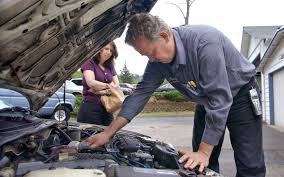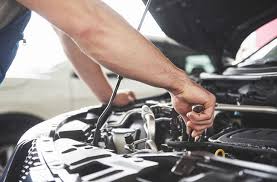Auto Repair Yourself – Fix Your Vehicles at Home For Less
Every time something goes wrong with your car, you have to take it in to the shop. With every repair, comes that hefty repair bill. As you look at the bill, you cannot imagine why it costs so much to fix your car. You think of how much money you could save if you could do auto repair yourself. However, like most people, you do not have a clue how to repair cars. However, you should be aware that there are many ways you can learn auto repair and can end up saving yourself quite a bit of money.
Friends and Family
If you have any friends and family that are knowledgeable about auto repairs, you should consult them and ask if they can help you learn some auto repair basics. If you have friends or family that are kind enough to help you learn how to repair your car, make sure that you give them something back for helping you. Perhaps there is something you can teach them, or maybe just take them out for a dinner.
Books
You can find tons of books dedicated to auto repair. These books will cover everything from the basics to more complex issues. You can find auto repair books at the local book store, at auto repair shops, or even at the library. If you are looking to buy a repair book, but do not want to spend too much, you should check out a used book store and see what repair books they have available.
If you choose to learn auto repair from a book, you should evaluate your learning process. Some people learn better from books than others. If you have a hard time learning from books, then this may not be the option for you. Also, it is important to know that some books are written better than others. It may be worth asking around and seeing what books are recommended for a beginner.
Internet
The Internet is a great resource to learn auto repair. You can find online repair guides to help you learn how to fix what is wrong with your car. Also, there are several discussion forums where people post tips on auto repair and where you can ask questions about your specific situation.
You can also purchase repair books online. You may find the repair books to be cheaper online than in brick and mortar stores.
Classes
Another option for learning auto repair yourself is to take a class. There are several places you can take an auto repair class. You can take a class from the local college or at a community center. These classes will often be taught in the evening or on weekends to accommodate work schedules.
Get To It
Now that you are aware of some of the ways to learn about auto repair, you should see what option will work best for you. Once you learn more about auto repair and can make repairs by yourself, you can save quite a bit of money for yourself and your family.

Easy DIY Car Repairs to Save Big
One of the monthly expenses many of us forget to include in our budgets is car repair and maintenance. Sure, we put down the price of gas, and maybe an oil change every two or three months, but we forget about most of the ongoing maintenance costs. Cars need regular maintenance over their useful lives, and most of us will pay through the nose to get it performed. But it doesn’t have to be that way. With parts bought online, some simple tools, and a little basic knowledge, many car repairs can be done without visiting a mechanic.
If you are lucky enough to have a garage or your own off-street work space, you might want to try your hand at a few DIY fixes in order to save some extra cash. Since dropping the tank to replace a fuel pump is not advisable for beginners, a cheat sheet containing a few easy DIY jobs is the best place to start. Remember, always research the task thoroughly beforehand via vehicle-specific online forums, reviewing PDF mechanic notes, and watching YouTube videos, as they are all indispensable resource. And know that since all cars are different, the ease (or lack thereof) of these projects will vary depending on what you drive.

Change Your Own Brake Pads
All you need is a wheel lug wrench, some basic wrenches, pliers, and of course a jack and set of jack stands (never get under a car unless it is on jack stands; you cannot rely on the jack as it may fail).
A set of new brake pads will set you back just $20–$40, depending on the car and pad material. Compare that to the industry average of $250 per axle, and you can see how much this DIY job will save you. The procedure is basic. Take off the wheel, remove the hardware, pull out the worn pads, push in the caliper piston, install the new pads, and reinstall the hardware. You should be able to do all four wheels in under an hour, even if this is your first time doing the job. The new pads will last between 30,000–50,000 miles, and you should check them every 10,000 miles. When the pad thickness falls below 2mm–3mm, it’s time for another replacement set.
Change the Battery
The average price of a new battery is around $80, although you can spend more or less depending on the make and model. A dealer will charge upwards of $200 to replace it.
To do the swap, you just need a basic set of wrenches. The biggest warning here, Reina says, is the order in which you remove the replace the cables. Remove the NEGATIVE (black) cable FIRST, and when you have installed the new battery, replace the NEGATIVE cable LAST. If you don’t do it this way, you could short circuit the positive (red) terminal to a grounded part of the car.

Do Your Own Oil Change
Buy a good quality oil filter and the best oil you can afford from your local supplier (it can be an auto specialist or a retail store). Other than jack stands and a jack, you’ll need an oil filter wrench and a drain pan. These only have to be purchased once and will last you decades (my father-in-law has been using the same drain pan for 20 years). You can find videos online walking you through oil changes on a variety of different vehicles.
Change Your Spark Plugs
There is an episode of the iconic TV series Frasier that shows Niles and Frasier Crane attending an automotive workshop. The very first lesson is how to change spark plugs. It’s one of the easiest home repairs you can do, although these days it is very rare you’ll even have to perform this service. On modern cars, extended-life spark plugs can maintain a precise gap for 100,000 miles. However, it is still wise to check them every 30,000-40,000 miles, just to make sure.
When the time does come to replace your spark plugs, along with your regular set of tools you will need a spark plug wrench. Again, this is a “buy once, use for a lifetime” kind of purchase, and it’s not very expensive (under $10 in most cases). (WikiHow has a great instructional piece here.) And the savings…let’s just say it’s significant. You can pay over $300 for spark plugs to be changed, and spark plugs themselves are rarely more than $30 for a set.
Replace a Headlight or Taillight
If you are a good car owner, you will perform a regular walk around of your vehicle. It’s important to do this for many reasons, but one of the biggest is to check that all the lights are working. Not only are lights essential for clear vision, and alerting drivers to your intentions, but you can also incur traffic tickets if they aren’t working. So, try and do this at least once a month (you’ll need someone to help you check the taillights).
If one (or more) isn’t working, it’s time to buy a replacement and do it yourself. With the average hourly repair rate of a garage being $100, you could easily spend $25–$50 per bulb, especially if the shop has a minimum charge.
One of the most important things to do is bring the old bulb with you to the store. You want to make sure you are getting like for like. And, when it comes time to change it out, never touch the bulb glass with your bare hands. The grease from your fingers can cause the bulb to burn out early.
Replace Your Air Filter
Richard Reina pointed out another simple fix that mechanics and dealerships will heavily mark up with labor costs and parts. And yet, it is a very quick fix (in most cases…if you happen to own a German import, you may have a few extra parts to remove to access the filter). On average, you’ll pay over $100 in labor costs, and $50 for the filter.
The typical cost of an air filter from a retail store is between $15–$20, but again, this can be higher depending on the make and model of your car. In most cases, you will simply have to open up the hood of the car, turn a few screws, open the air filter housing, swap out the old for the news, and replace the screws. It really is that simple, and you can save a ton of money doing it yourself.